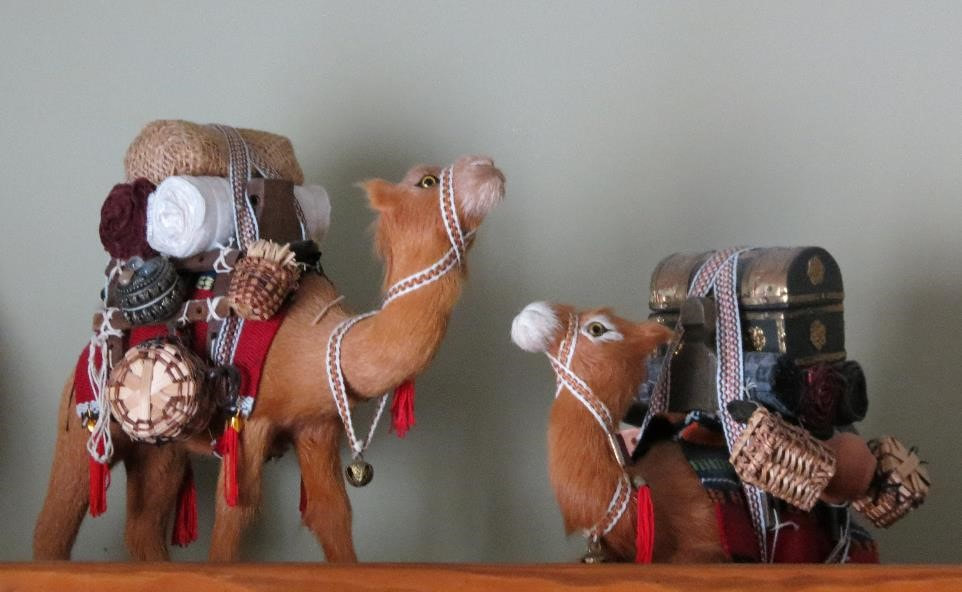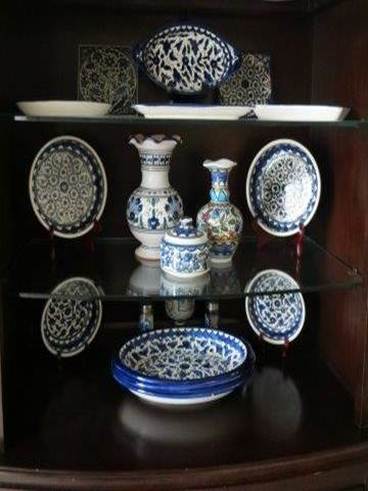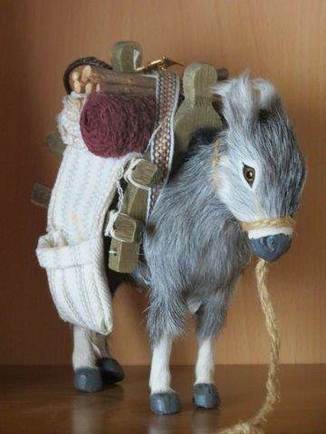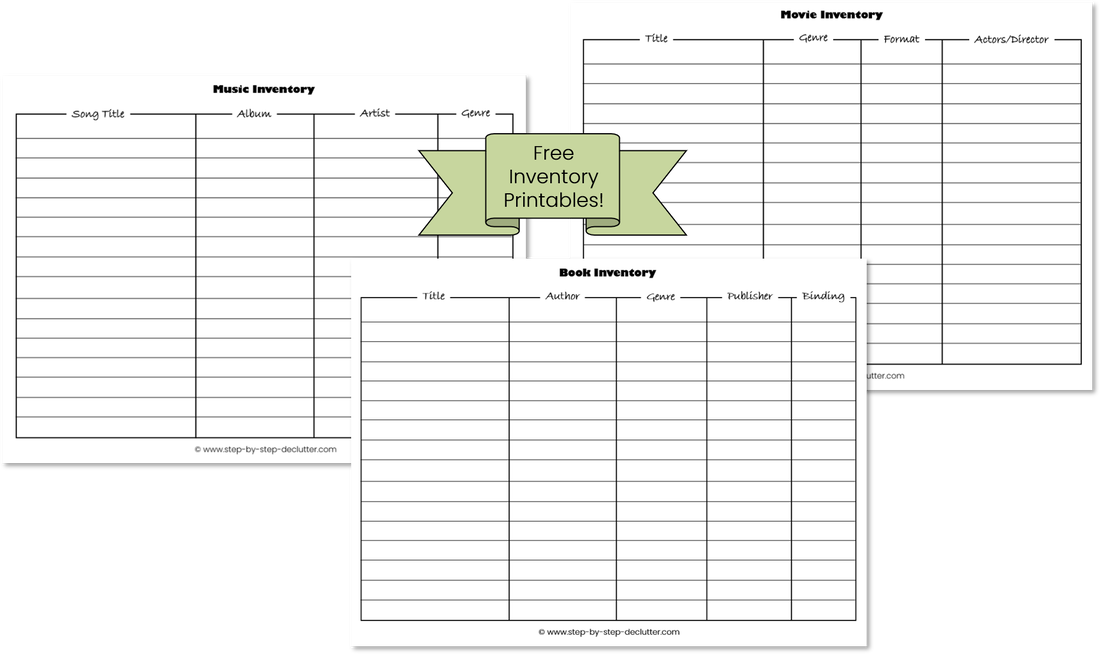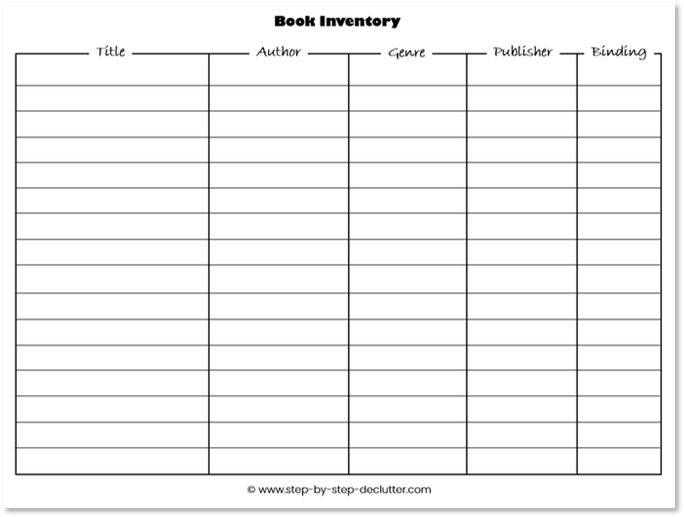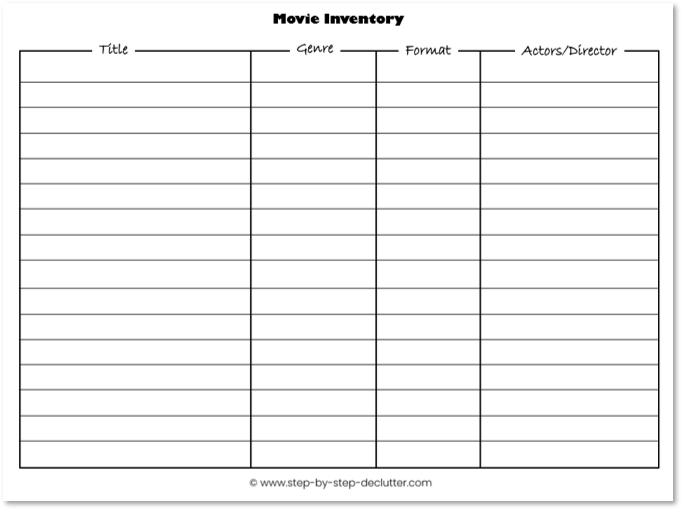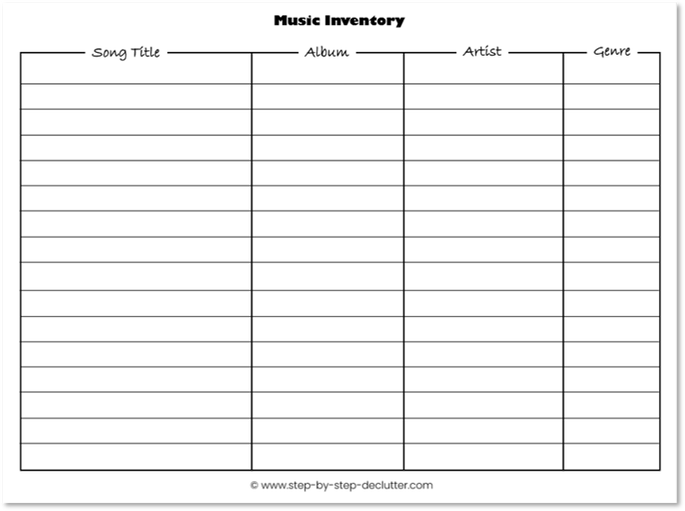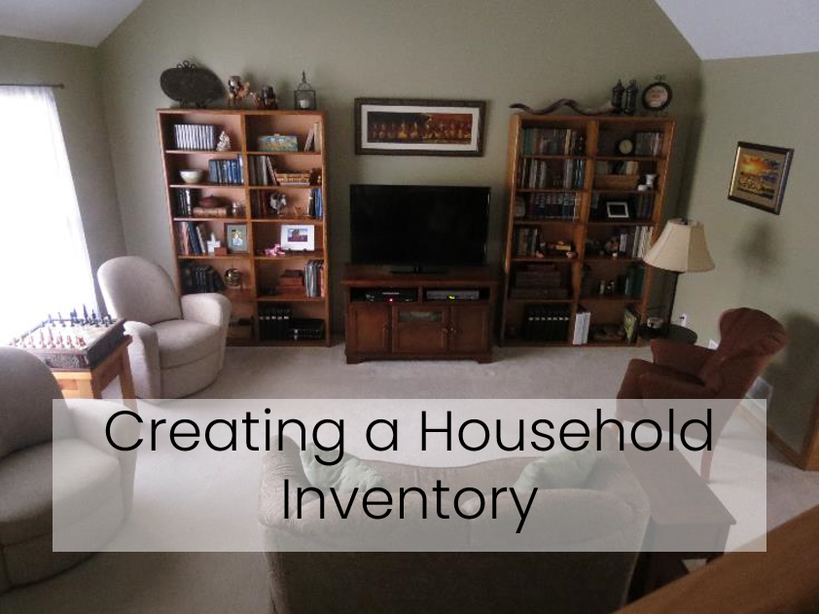|
|
Creating a Household Inventory |
|
A household inventory provides a detailed record of all your possessions. Its purpose is to expedite the claims process in the event of loss, theft, or damage – all of which are possible during a move, so it's a good idea to prepare one if you are planning on moving.
While it takes time to put together an inventory, the security it provides cannot be underestimated. Here are some of the benefits you’ll receive from producing a household inventory:
While it takes time to put together an inventory, the security it provides cannot be underestimated. Here are some of the benefits you’ll receive from producing a household inventory:
- It makes filing a claim with your insurance company (or moving company) much quicker and easier.
- It can be used by your insurance company to identify and provide adequate and accurate compensation for everything covered under your homeowners’ or renters’ insurance policy.
- In the event of loss or theft, it will help you to determine which items are missing. This can be very useful if you have boxes missing from your shipment since boxes usually only have a general description (such as ‘kitchen items’) on the inventory.
- It provides a record of model and serial numbers which can be used to identify your items if stolen.
- It can help you determine the correct amount of insurance coverage you need.
- Having model numbers, serial numbers, and dates of purchase in one convenient location also makes it easy to find what you need should it become necessary to replace or repair an item under warranty.
What to Include in a Household Inventory
|
|
Your household inventory can be as simple or as detailed as you like, but it should include the following information:
- Name of item
- Manufacturer
- Model number (where applicable)
- Serial number (where applicable)
- Date of purchase
- Purchase price (for electronics and other big ticket items)
- Estimated value of item (particularly in the case of antiques, collectibles, etc.)
- Image of item (photograph or video)
It’s also a good idea to include a description of each item when appropriate. In the case of electronics, this might include special features. In the case of antiques, include the date of the piece as part of the description. You can also use the description column to identify family heirlooms as well as one-of-a-kind or custom made pieces.
Another good policy is to keep receipts for all major purchases and for any items that include a warranty. Include a column on your inventory to indicate whether or not you have a receipt for the item. If you do not have a receipt for an important item, bank/credit card statements can be used in some cases. In addition, you can look at your order history to determine the cost of an item and the date of purchase for items purchased online.
Any other pertinent transaction documents should be included with your inventory as well. These might include certificates of authenticity, appraisals, and so forth. All purchase documentation should be scanned in order to retain an electronic copy of the information.
Another good policy is to keep receipts for all major purchases and for any items that include a warranty. Include a column on your inventory to indicate whether or not you have a receipt for the item. If you do not have a receipt for an important item, bank/credit card statements can be used in some cases. In addition, you can look at your order history to determine the cost of an item and the date of purchase for items purchased online.
Any other pertinent transaction documents should be included with your inventory as well. These might include certificates of authenticity, appraisals, and so forth. All purchase documentation should be scanned in order to retain an electronic copy of the information.
|
|
Keeping Track of Receipts
|
|
For important purchases and items under warranty, I recommend scanning the receipt to make an electronic copy and then stapling the original to the warranty or instruction manual. It just makes sense to file the receipt with the warranty since both will be needed in the event of a problem. The reason for an electronic copy is that the method of printing used to produce most receipts actually causes fading over time.
Receipts/Warranties can then be filed in large plastic envelopes with snap button closures according to type (kitchen appliances, sports equipment, power tools, etc.). You could also use accordion-style envelopes to file your manuals/receipts.
Receipts/Warranties can then be filed in large plastic envelopes with snap button closures according to type (kitchen appliances, sports equipment, power tools, etc.). You could also use accordion-style envelopes to file your manuals/receipts.
How to Record Your Inventory |
|
|
A household inventory could consist of a simple visual record of your possessions. You can make a visual record using photographs or video. A visual record is useful for establishing proof of ownership. It also provides evidence of the condition and appearance of items. It is a good place to start, but it is not recommended as the only record of your belongings.
For added security, you will want to maintain a written record as well. You can do this by designing your own spreadsheet, or you can utilize one of the many apps designed for this purpose. Check out Insuramatch's article on The Best Home Inventory Apps (2018), or 9 Best Home Inventory Apps to Protect Your Belongings (2021) from Hippo to get a sense of what's available. |
Getting it all Together
|
|
Once you've determined the method for recording all your information, you’re ready to get to work. Tackle one room at a time until you are done. Be sure to capture every area of your home including your basement, attic, garage, and any outdoor structures (shed, shop, carriage house).
Record all items of value to include:
Record all items of value to include:
- Antiques
- Appliances
- Artwork/paintings
- Books, movies, games
- Carpets/rugs
- Clothing
- Collectibles
- Electronics (TVs, DVD players, stereos, video game systems, computers and other office equipment)
- Furniture
- Jewelry
- Kitchen equipment (pots, pans, etc.)
- Lamps and accessories
- Linens
- Silverware/china/crystal/silver serving pieces
- Sports/exercise equipment
- Tools
- Toys
- Window treatments and wall hangings
Capture a wide angle view of each room to demonstrate the magnitude of the loss in the event of a disaster. Then zoom in on specific areas of the room and individual items.
For instance, in the case of a book collection, you will not want to take separate images of each book. A view of the bookcase lined with books is sufficient. However, if you have a particularly valuable book, such as a first edition of a classic, you may want to photograph it separately.
For instance, in the case of a book collection, you will not want to take separate images of each book. A view of the bookcase lined with books is sufficient. However, if you have a particularly valuable book, such as a first edition of a classic, you may want to photograph it separately.
|
|
Creating a Media Inventory |
|
We don’t typically think of individual books, movies, or games as ‘big ticket’ items, but if you have a large collection of any or all of these things, they represent a hefty investment on your part. I recommend preparing a separate inventory for these items. It can be done simply using a spreadsheet with separate tabs for each category. Free printable inventory forms are available below.
Maintaining an inventory ensures you will receive adequate compensation should anything happen to your collection. In the case of a move, it makes it possible to determine which books/movies/CDs are missing should one or more boxes disappear.
Your book inventory should include title, author, publisher, genre, and type of binding (hardback, paperback, library binding).
A movie inventory could be a simple list of titles. However, you may also wish to include genre, director, producer, starring actors, the year a movie was released or any other information that interests you.
If you still maintain a large collection of music CD's, you may want to create a music inventory. Recommended information for such an inventory would include album title, artist, and genre.
In addition to title, video game inventories could include rating and game system such as Wii, PlayStation, or Xbox (particularly if you have more than one system).
We have a large collection of lectures on disc from The Great Courses® for which we keep an inventory; it's just a separate tab in the library inventory (which we have created in Microsoft® Excel). We also have a tab for board games.
As with any inventory, it is only useful if it is accurate. Be sure to update your inventory whenever you make a purchase or get rid of an item. We got lax about this and it was a huge chore to update it.
Maintaining an inventory ensures you will receive adequate compensation should anything happen to your collection. In the case of a move, it makes it possible to determine which books/movies/CDs are missing should one or more boxes disappear.
Your book inventory should include title, author, publisher, genre, and type of binding (hardback, paperback, library binding).
A movie inventory could be a simple list of titles. However, you may also wish to include genre, director, producer, starring actors, the year a movie was released or any other information that interests you.
If you still maintain a large collection of music CD's, you may want to create a music inventory. Recommended information for such an inventory would include album title, artist, and genre.
In addition to title, video game inventories could include rating and game system such as Wii, PlayStation, or Xbox (particularly if you have more than one system).
We have a large collection of lectures on disc from The Great Courses® for which we keep an inventory; it's just a separate tab in the library inventory (which we have created in Microsoft® Excel). We also have a tab for board games.
As with any inventory, it is only useful if it is accurate. Be sure to update your inventory whenever you make a purchase or get rid of an item. We got lax about this and it was a huge chore to update it.
|
Larger items such as furniture, appliances, and electronics should be photographed separately. Zoom in on brand names, model numbers, and (if possible) serial numbers. In addition, high value items such as jewelry or collectibles should be individually photographed.
If videotaping your possessions, be sure to include an audio commentary as you progress from room to room. Zoom in on high value items and provide any pertinent information in your commentary. Make sure all photos and video are dated. |
Free Printables |
|
Use these printable inventory forms to keep track of your media collection. Print as many copies of each form as you need to keep track of your books, movies, or music. Place the completed forms in a binder with tabs for each type of inventory.
Click on the images below to print each inventory.
Book Inventory
Movie Inventory
Music Inventory
Storing and Maintaining Your Inventory
|
|
Once your household inventory is complete, you will want to make a copy of everything associated with it. This includes photos, video, receipts, and appraisals, in addition to the inventory itself.
Store one copy of your inventory in a safe location, preferably outside your home since its main purpose is to serve as a record of your belongings in the event of a disaster. The safest option is to keep a copy in a bank safe deposit box, or online safe deposit box. Another option is to make a copy to keep at the home of a close friend or relative.
Store one copy of your inventory in a safe location, preferably outside your home since its main purpose is to serve as a record of your belongings in the event of a disaster. The safest option is to keep a copy in a bank safe deposit box, or online safe deposit box. Another option is to make a copy to keep at the home of a close friend or relative.
You will need to update your household inventory every six months or so. Remove any items you no longer possess and add new items. Major purchases should be added as soon as possible. When you move, you should hand carry your household inventory as proof of value should you need to file a claim for a lost or damaged item.
|
|
Determining Your Insurance Needs
|
|
Add up the estimated values of all the items on your inventory. Use this figure to determine whether or not your homeowner's insurance accurately reflects your needs and adjust your policy accordingly.
Put together a household inventory and enjoy peace of mind knowing you will be adequately compensated in the event of loss, theft, or damage.
Please Share
|
|
If you found this page helpful, please share it on social media. Feel free to leave a comment below as well. I would love to hear from you.
Proudly powered by Weebly
